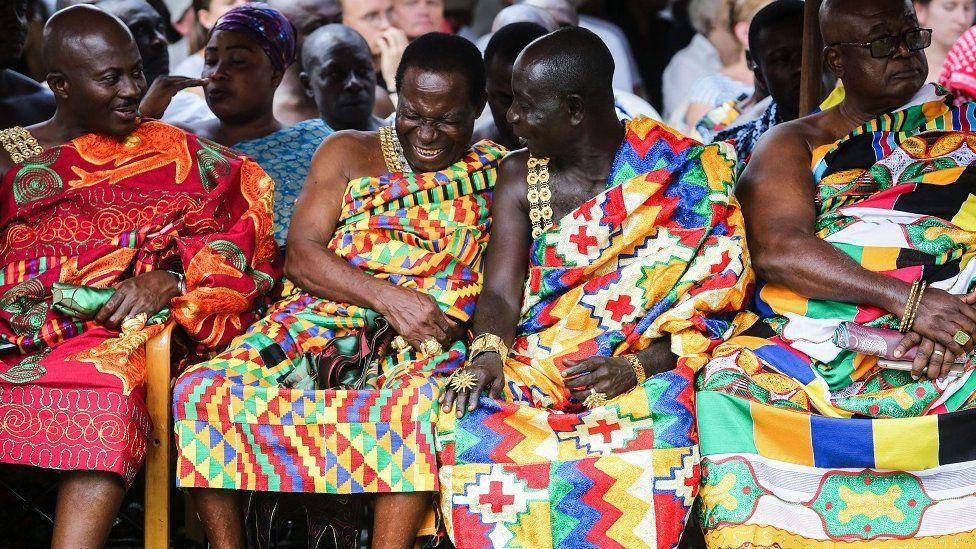Unveiling the Splendor of Kente: A tapestry of Ghanaian Heritage
Introduction
Table of Contents
The tapestry of Kente unfolds as a vibrant canvas that celebrates the artistry and heritage of the Ghanaian people. This exquisite fabric, crafted with intricate patterns and bold colors, has long been a symbol of royalty, wealth, and cultural pride. A true masterpiece of weaving, Kente continues to captivate the world with its timeless beauty and ancient meaning.
Origins and History of Kente
Kente’s origins can be traced back centuries ago to the Ashanti Kingdom in present-day Ghana. legend has it that the fabric was first inspired by the intricate patterns of a spider’s web.It was initially woven exclusively for royalty and high-ranking officials, earning its status as a symbol of power, authority, and social prestige.
Over time, Kente’s popularity spread beyond the Ashanti Kingdom, becoming a cherished fabric worn by all levels of society. Its vibrant colors and elaborate designs became synonymous with Ghanaian identity and a celebration of the country’s rich traditions.
Symbolism in Kente
The patterns and colors of Kente are meticulously chosen, each holding deep symbolic meaning. Some common motifs include:
- Adinkra Symbols: Represent proverbs and concepts from Ghanaian culture.
- Geometric Patterns: Reference conventional weaving techniques and natural forms.
- Color Combinations: Symbolize personality traits, emotions, and social status.
For example, the “sankofa” symbol, depicted as a bird with its head turned backward, represents the importance of learning from the past. The “wisdom knot” pattern symbolizes unity and cooperation.
The Art of Kente Weaving
Weaving Kente is a labor-intensive and time-consuming process that requires great skill and patience. It is traditionally woven using a horizontal loom, with threads of silk, cotton, or rayon.The intricate patterns are created by carefully manipulating the warp and weft threads.
The weaving is often done by hand, with the weaver sitting on a low stool and using foot pedals to control the loom. The entire process can take several days or even weeks to complete.
Global Impact of kente
Kente’s exquisite beauty and unique symbolism have captured the attention of fashion designers and style enthusiasts worldwide. In recent decades, it has become a popular choice for garments, accessories, and home décor.
celebrities and fashion icons have been spotted sporting Kente, from Beyoncé to Michelle obama. The fabric has also been featured in high-fashion runways and international exhibitions, showcasing the global appeal of ghanaian artistry.
Practical Applications of Kente
Beyond its cultural and aesthetic value, kente also has practical applications:
- Clothing: Traditional ghanaian garments, such as the “kaba” and “slit” skirt, are often made of Kente.
- Accessories: Kente scarves, bags, and jewelry are popular accessories that add a touch of african elegance to any outfit.
- Home Décor: Kente fabrics can be used to create vibrant cushions, throws, and wall hangings, infusing any space with Ghanaian warmth and style.
Kente in Modern Ghana
Today, Kente remains an integral part of Ghanaian society. It is worn at special occasions, such as weddings, funerals, and cultural festivals. It is also a symbol of national unity and pride, and is often used to represent Ghana internationally.
The government has implemented initiatives to preserve and promote Kente, including the establishment of the National Kente Society and the creation of kente weaving workshops.these efforts aim to ensure that this traditional art form continues to thrive for generations to come.
Conclusion
Kente is more than just a fabric—it is a living testament to the creativity, ingenuity, and cultural heritage of the Ghanaian people. Its vibrant colors, intricate patterns, and deep symbolism have captivated the world, inspiring fashion and art across the globe.As a symbol of royalty, identity, and resilience, Kente continues to weave its magic, connecting Ghanaians around the world and celebrating the rich tapestry of African culture.

